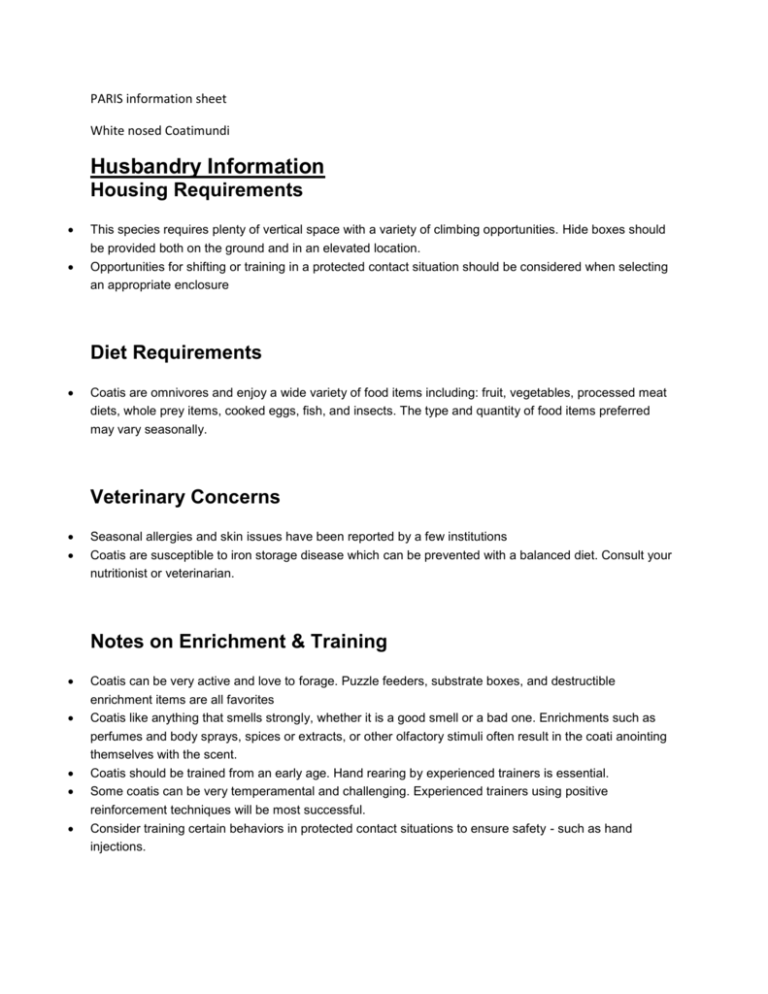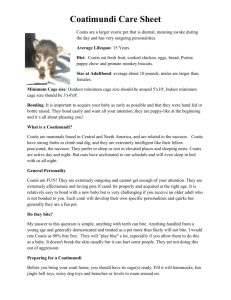Husbandry Information
advertisement

PARIS information sheet White nosed Coatimundi Husbandry Information Housing Requirements This species requires plenty of vertical space with a variety of climbing opportunities. Hide boxes should be provided both on the ground and in an elevated location. Opportunities for shifting or training in a protected contact situation should be considered when selecting an appropriate enclosure Diet Requirements Coatis are omnivores and enjoy a wide variety of food items including: fruit, vegetables, processed meat diets, whole prey items, cooked eggs, fish, and insects. The type and quantity of food items preferred may vary seasonally. Veterinary Concerns Seasonal allergies and skin issues have been reported by a few institutions Coatis are susceptible to iron storage disease which can be prevented with a balanced diet. Consult your nutritionist or veterinarian. Notes on Enrichment & Training Coatis can be very active and love to forage. Puzzle feeders, substrate boxes, and destructible enrichment items are all favorites Coatis like anything that smells strongly, whether it is a good smell or a bad one. Enrichments such as perfumes and body sprays, spices or extracts, or other olfactory stimuli often result in the coati anointing themselves with the scent. Coatis should be trained from an early age. Hand rearing by experienced trainers is essential. Some coatis can be very temperamental and challenging. Experienced trainers using positive reinforcement techniques will be most successful. Consider training certain behaviors in protected contact situations to ensure safety - such as hand injections. Programmatic Information Tips on Presentation This species likes to climb so using a branch, railing, or perch helps to demonstrate its abilities. Be sure to use a secure harness for presentations and walks. Coatis are curious and enjoy exploratory walks around zoo grounds. If acclimated to a variety of stimuli from a young age, coatis are relatively fearless. Tips on Handling Coatis can have very sharp claws if they are not trimmed. Untrimmed claws may be desirable for security and confidence when learning or demonstrating climbing skills. Thus the coati should not be allowed to climb handlers as this will have unpleasant results. Being carried in the handlers arms can be useful but should be initiated by the handlers’ invitation. As they are social, many coatis love to be petted and groomed by their handlers. If doing so during a presentation, be sure to message this properly. Potential Messaging Educated pet choices. While available in the some areas in the pet trade, coatis are challenging and difficult as pets. They are messy, can be destructive and require an immense amount of time, space, and resources. They also have sharp teeth and claws and an aggressive incident could send the handler to the emergency room. Domestic animals are a much better choice for a pet. Unique adaptations. Coatis have many fun adaptations for their arboreal and omnivorous lifestyle. Their flexible nose can poke into nooks and crevices looking for grubs. Stinging invertebrates are rolled on the ground rapidly under the thick pads of the forefeet to disable the arthropod by removing urticating hairs and ineffectively discharging the defensive chemicals before they consume it. Coatis are agile tree climbers using their sharp claws and dexterous feet to grip the bark while their long tail acts as a counterbalance. In addition coatis can rotate their ankles backwards to descend trees headfirst. Social structure. Reliance on fruit as well as the pressures of predation avoidance helped form the coati’s unique social structure of solitary males and female coalitions. Female and juvenile coatis live in groups of 5-25 individuals called bands. These coalitions are maintained by reciprocal altruism and are very stable. Members of the band all help care for and guard juveniles allowing females to spend more time foraging. This very successful coalition strategy increases the survival rate for juveniles and allows young to mature faster. Females mature in their second year and males mature in their third at which time they are expelled from the band. Acquisition Information A few zoos have breeding pairs. Contact the SSP leader for more information. Comments from the Rating System Coatis require an experienced handler but are a dynamic and unusual presentation animal suitable for a variety of presentations. Natural History Information Range and Habitat White-nosed coatis are native to Central and the northern parts of South America and since the twentieth century have expanded their range to include parts of the southern United States. White-nosed coatis inhabit a variety of habitats usually woodlands and open forests including dry forests, rain forests, and cloud forests, and can sometimes be found in open grasslands and deserts. Physical Description The coati has an elongated body covered in short dense fur varying dramatically in color between individuals. The snout is long and slender, projecting well beyond the lower lip. The long tail has six or seven indistinct light bands and is usually held upright and is used for balance. The front legs are short and strong with longer hind limbs, giving the coati a rocking bear-like gait. Males are significantly larger than females. Weight: Males average 4.5-9 kg (9 to 20 pounds) but have been recorded at 11kg. Females 3.5 5 kg (8 to 11 pounds) Length: 80-130 cm (32-50 inches), little over half being tail Height: up to 30 cm at the shoulder (12 inches) Life Cycle After a gestation period of approximately 77 days 2-7 young are born. Common litter size is 3-5 cubs. Young are weaned at about 4 months old but do not reach adult size until about 15 months of age. Behavior Female and male coatis differ greatly in their behaviors due to their social and solitary lifestyles respectively. Female coatis are primarily diurnal especially in the early morning and late afternoon. Mature solitary males are often active at night. Coatis often groom each other to strengthen social bonds or show supplication, using their long claws and small incisors they comb and pick parasites through each other’s fur. Coatis usually sleep in trees and come to the ground to forage. Their ringed tails are held erect as they move to help keep track of each other. Threats and Conservation Status White-nosed coatis are classified by the IUCN as a species of Least Concern although their population in some areas is decreasing. These local threats are a result of ongoing habitat loss and hunting. Did you know… A coati can bend its nose 60 degrees in any direction. Coatimundi means “lone coati” in Guarani and is used to refer to a solitary male while the term coati is used to refer to an individual that is a member of a band. When initially discovered, scientists thought male and female coatis were different species because of their vastly different lifestyles.








